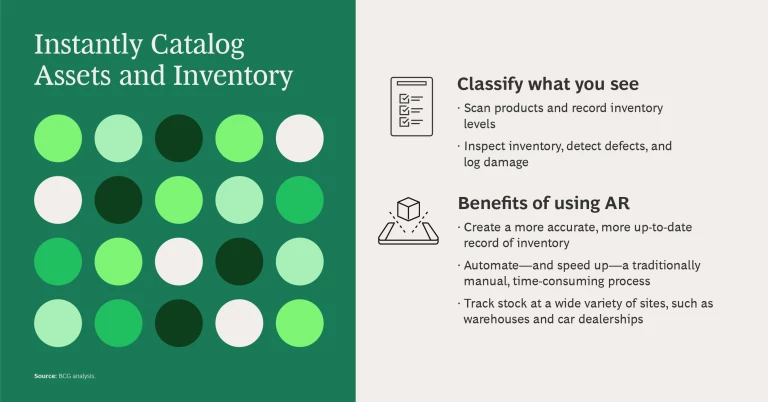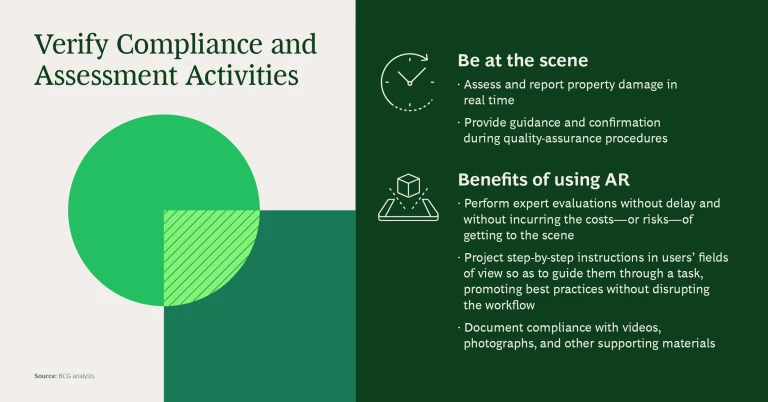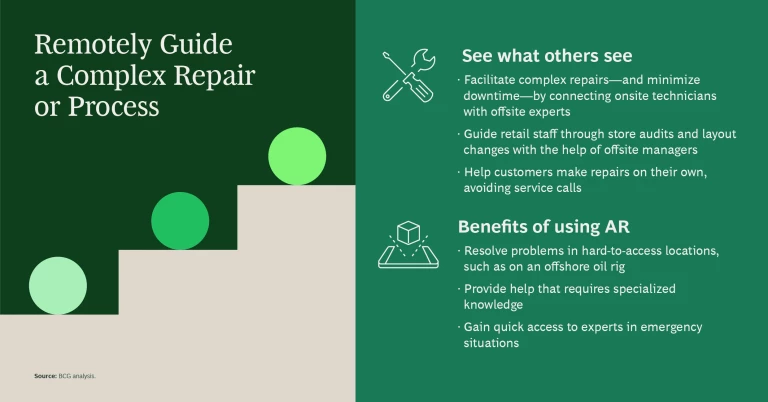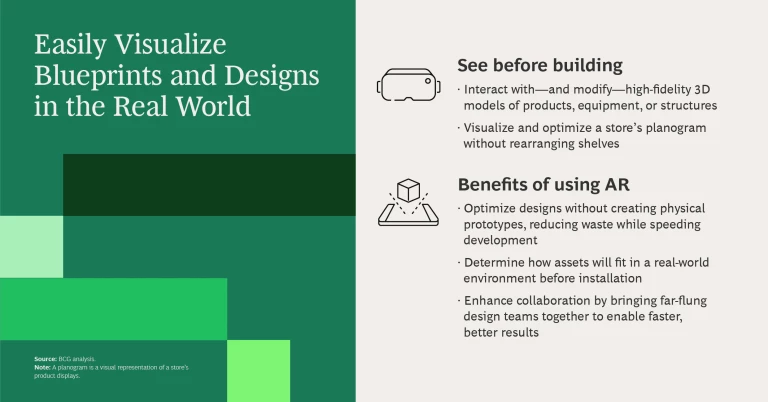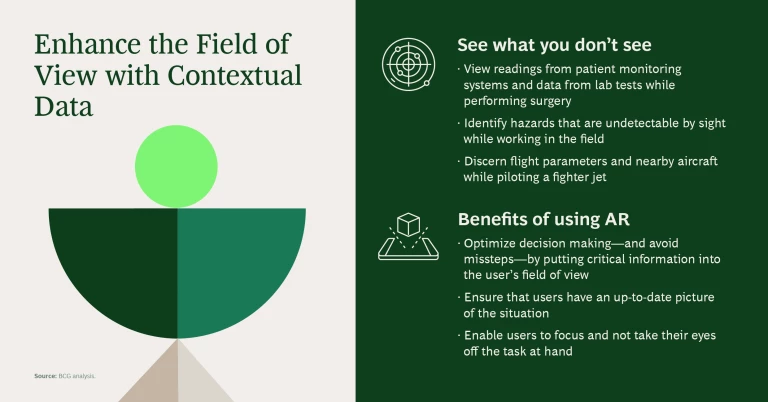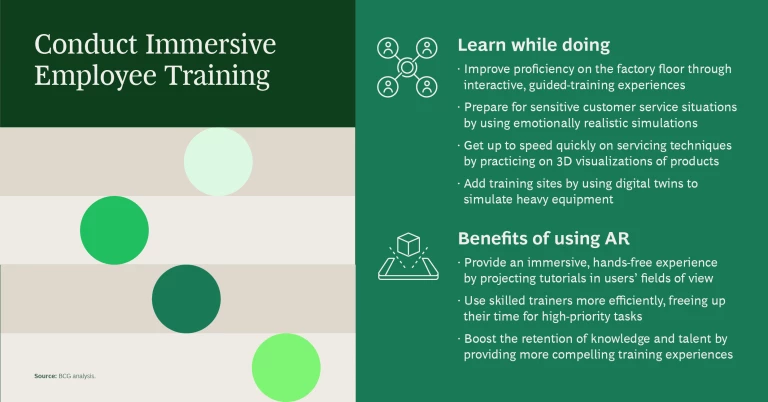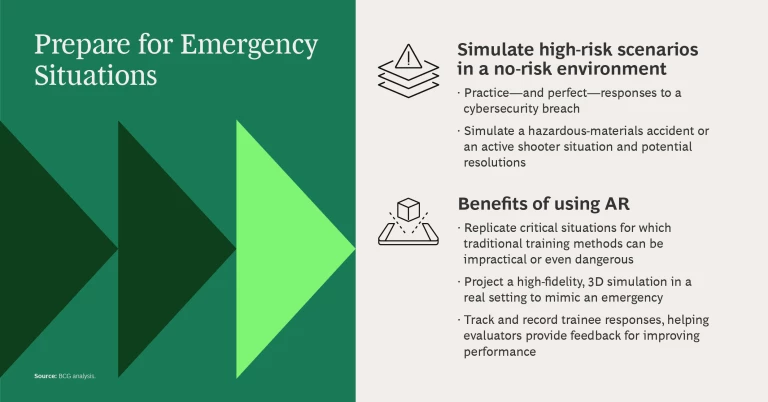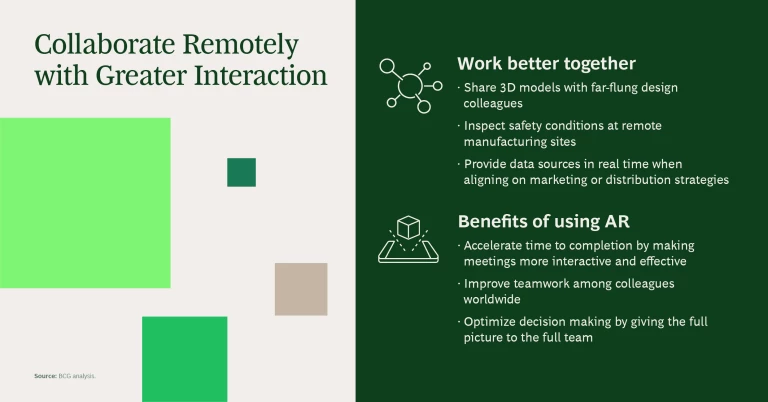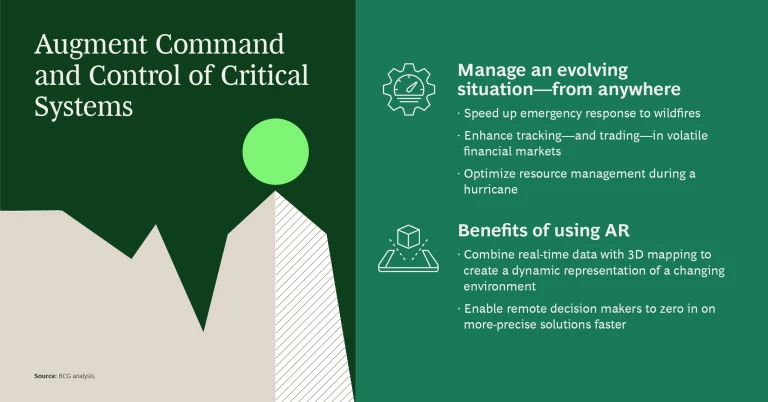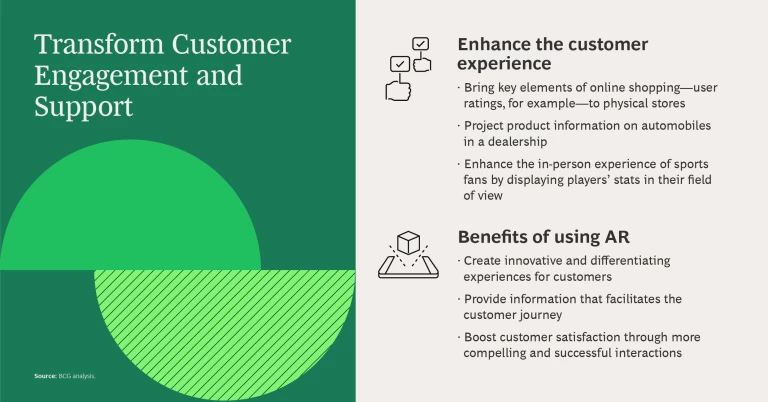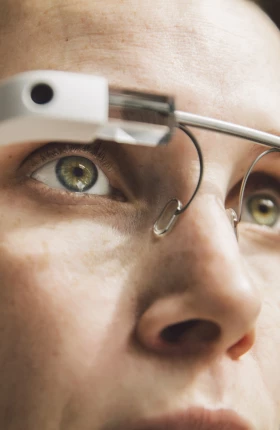Vision Pro—Apple’s wearable spatial computing device—has sparked new discussion around augmented reality (AR). The conversation is overdue. For many companies, AR is largely an unknown; they see it as a technology for gamers or enthusiasts. But for businesses that deploy it wisely, AR is a game changer. By checking many boxes—dramatically different and better customer experiences, greater efficiency and productivity, and new revenue streams—AR can transform the competitive landscape.
By bringing information from our digital world into our physical space, AR unleashes the value of context and enables more informed—and more precise—decision making. A remote expert, thousands of miles from an equipment failure, can steer a technician through a complicated repair. A consumer who is buying a chair online can see if it will fit under the kitchen table before making the purchase. The list goes on.
But there’s the rub. To seize the potential, business leaders need to zero in on where—of all its possible applications—AR really makes a difference. In which scenarios does AR let users interact in ways that aren’t possible with current technology to get faster or better results, or both? The challenge is that without experiencing AR in action—without getting a clear picture of how it can benefit their business—many companies struggle to find the right applications and justify investing.
Our work with early AR adopters, as well as discussions with executives, practitioners, and experts in the AR space, reveal a broad spectrum of applications. But we also found that the most compelling uses fall under ten distinct scenarios. By exploring these, companies can more easily identify how, and where, AR matters most for their business.
Ten Paths to Value
Virtual reality immerses users in a computer-generated environment; AR keeps them right where they are, in the real world. But AR does enhance the view. It superimposes a layer of digital information (such as sensor readings, repair instructions, or the locations of invisible hazards) on the physical environment. Since users typically see this information by wearing goggles or glasses (as opposed to accessing a phone or tablet), their hands are free to work and interact as usual.
These capabilities fuel the ten AR scenarios presented in the slideshow. While each scenario creates value in a unique way, none are industry specific. Health care , manufacturing , operations , and retail may be the most obvious candidates for AR, but just about any kind of business can put the technology to work.
For many first movers, the appeal of AR is straightforward: it supports—and enhances—mission-critical operations. Some of these organizations rely on complex processes and equipment that demand a high level of technical know-how, and the cost of downtime is high. Others depend on training programs that, traditionally, have been expensive and asset-intensive, tying up equipment and staff.
But no matter the needs or business model, early adopters tend to share a key trait: they’ve committed to a broader digital transformation . By anchoring information from the digital world in the physical world, AR is a natural enabler of that transformation—and a crucial one as businesses develop a metaverse strategy . As such, AR’s appeal becomes nearly universal.
Indeed, a closer look at three of the more prominent scenarios demonstrates the power and reach of AR.
Complex Repairs with Guidance from Remote Experts
Troubleshooting sophisticated equipment often requires specialized know-how that’s not available onsite. AR reduces delays by bringing remote experts onto the scene—effectively, if not literally. An onsite technician dons AR goggles, which let a remote expert see what the technician sees. The expert can then walk the technician through the repair and even sketch digital cues (such as arrows showing which way to turn a valve) in the person’s field of view. By seeing equipment in its actual operating environment, experts can better understand—and factor in—any interdependencies that may be at play, fostering more effective and efficient solutions.
AR-enabled repair is particularly well suited for critical equipment (such as power generators in a hospital) as well as equipment (such as automobiles) at various locations. Porsche has shortened its service resolution time by up to 40% since deploying AR to link technicians at its dealerships with experts at the company’s headquarters.
But it doesn’t have to be a technician who dons the goggles. HP has introduced an AR-based support solution, HP xRServices, that enables industrial printer customers to connect with HP experts, who guide the customers through troubleshooting and problem solving. This lets HP deploy a highly skilled support staff more effectively, resulting in fewer onsite service calls, faster diagnoses, and minimal downtime for customers.
Immersive, Interactive Training
Whether onboarding new hires or upskilling an existing workforce, businesses can leverage 3D visuals and spatial audio to provide a more immersive training experience. Employees learn while doing, receiving immediate feedback in highly realistic and interactive simulations. This kind of training is especially useful in preparing for emergency-response situations or in learning how to handle complicated or sensitive customer service situations. And since it is often self-guided, AR training can free up experts to focus on other high-priority tasks.
Immersive training can also be a boon to companies that operate or sell complex products. Consider Atlas Copco, which makes specialized industrial equipment, such as vacuum pumps that are used in MRI machines and spacecraft. The company employs AR to project at-scale 3D visualizations of its products during training sessions, enabling technicians to more easily—and more effectively—get up to speed on all the parts and learn how to service the equipment.
At Toyota, AR has expanded the reach of the automaker’s training staff. Instead of providing one-on-one guidance, trainers can now work with several people at the same time. For companies that frequently modify key processes (as happens with the launch of each new car design), more efficient training means faster—and more seamless—transitions.
A company doesn’t need to be an industrial giant to reap the benefits of next-generation training. Many AR solutions incorporate low-code or no-code technology , which lets businesses of all stripes develop customized AR-guided learning solutions. Another benefit: by expanding and enhancing training, companies can more easily develop talent, sparking higher employee satisfaction and retention rates.
Many AR solutions incorporate low-code or no-code technology, which lets businesses of all stripes develop AR-guided learning solutions.
Enhanced and Dramatically Different Customer Experiences
By using AR, organizations can provide more interactive and personalized experiences, deepening their relationship with those they serve. Retailers can bring key elements of online shopping to their physical stores, for example, by using AR to display reviews about products on the shelves. And they can extend their shelves by using AR to show product variations that don’t fit or will be in stock shortly. A sports team, meanwhile, can enhance its television broadcasts by projecting 3D replays on demand or by overlaying statistics at different levels of detail, depending on the type of fan.
The applications—and the possibilities—are wide ranging. Wayfair, the online home store, developed an AR-based interior design and planning application that lets customers position full-scale 3D models of furniture in their home, so they can see how different products fit in a room. Fans of the Los Angeles Rams can catch a virtual football thrown by a player on the team—or at least, the player’s holographic representation.
Or consider an innovative use of AR at the Cleveland Museum of Art. As part of its Revealing Krisha: Journey to Cambodia’s Sacred Mountain exhibition, the museum created a life-size 3D model of the cave temple where a 1,500-year-old stone sculpture—Krishna Lifting Mount Govardhan—appears to have stood. Visitors who wore headsets while walking through the exhibit hall experienced the sculpture in its original environment. In effect, the museum put the visitor at the scene.
Getting Started with AR
Companies that create value through AR understand the possibilities, but crucially, they recognize where they’ll see the best return on investment. The following practices can help leaders view AR through a precision lens—and zero in on the right use cases.
- Know the pain points. AR can help a company tackle, even solve, many operational challenges. So before deploying the technology, it’s important to know the pain points and how AR solutions may help. Start by mapping key workflows and identifying high-cost and high-risk activities. For each of these, think about outcomes that would create value, such as less costly or less asset-intensive training or more efficient use of factory equipment. Then consider how AR could drive those outcomes.
- Weigh the alternatives. AR may not be the only or best option. Could a technology other than AR—one that is already used or one that could be deployed faster and at less cost—also tackle the pain point? Just be sure that the alternative will truly suffice. This means understanding any social, safety, or industry constraints that may hinder a more traditional approach but that may not apply to AR.
- Understand the total cost of ownership. An AR investment isn’t just about buying hardware. A company should consider the costs—in terms of time as well as money—related to software licensing and customization, connectivity, and employee training. By weighing these costs against the expected benefits, leaders can make the business case for AR. They can also prioritize initiatives, ensuring that they start with those that matter most for the business or provide quick wins that build momentum.
- Develop the right success metrics. After piloting AR, track the results. That means identifying concrete (and ideally quantitative) success criteria for goals such as less downtime for equipment, shorter waiting time for customers, or lower costs for employee training. Relevant KPIs aren’t always obvious: many AR use cases have secondary benefits, such as improving employee retention. The idea is to consider all the benefits that were identified when developing the business case and think about how to measure them once AR is in action.
- Have a plan for change management. AR brings rewards, but also changes: employees will work in new ways and with new tools. It’s important to ease the transition and minimize disruption to the business. We recommend a gradual approach to AR. Instead of wide-scale deployment out of the gate, pilot one use case with a small group of employees, then expand it to another group. Invest resources in training—upfront—but expect some growing pains. It’s common to see decreased efficiency, for example, in the early phase of a rollout. Create dedicated support teams to provide guidance and best practices. Remember to continually—even zealously—track the KPIs. And when the numbers look good, get the word out. Demonstrating the success of AR is the best way to create buy-in from employees and management alike. It helps leaders fuel (and fund) the journey—and do even more with AR technology.
AR is all about enhancing one’s field of view. But with so many ways to put AR to work, it’s vital to understand where—and how—the technology creates value. Companies that see the best fit may well see something more: differentiation, growth, and competitive advantage.


